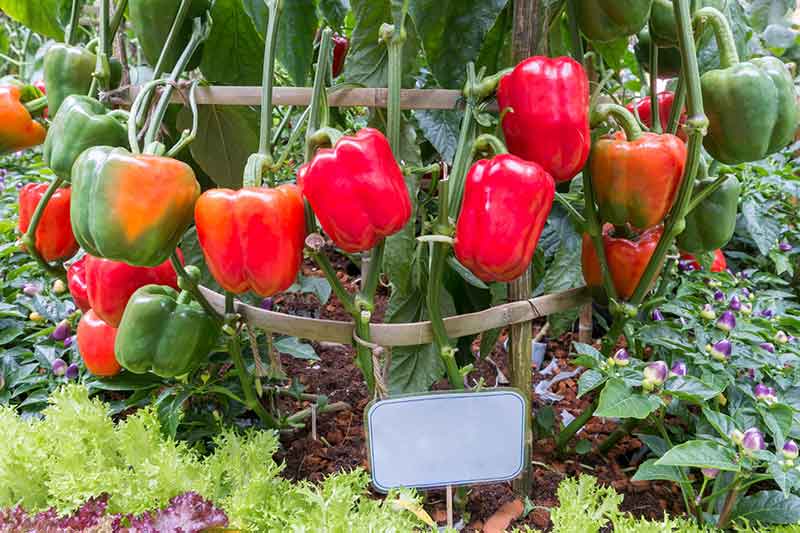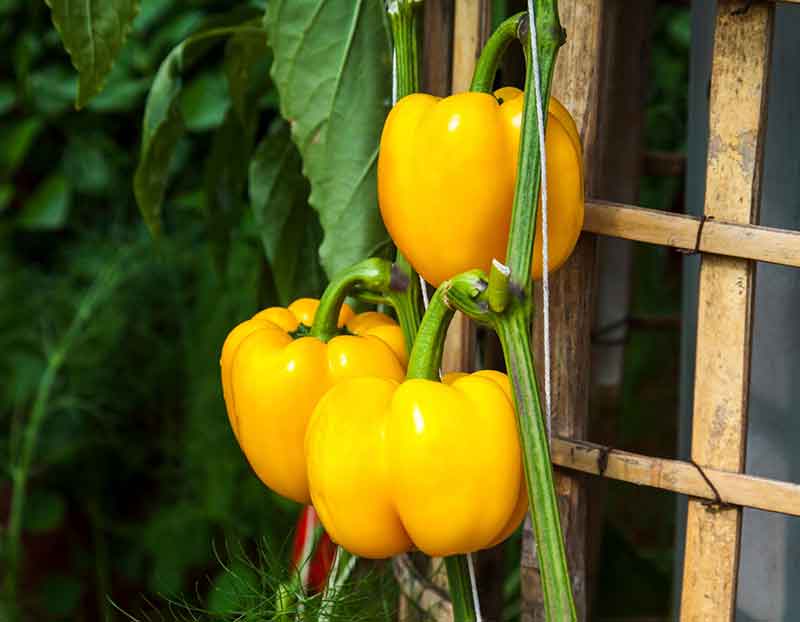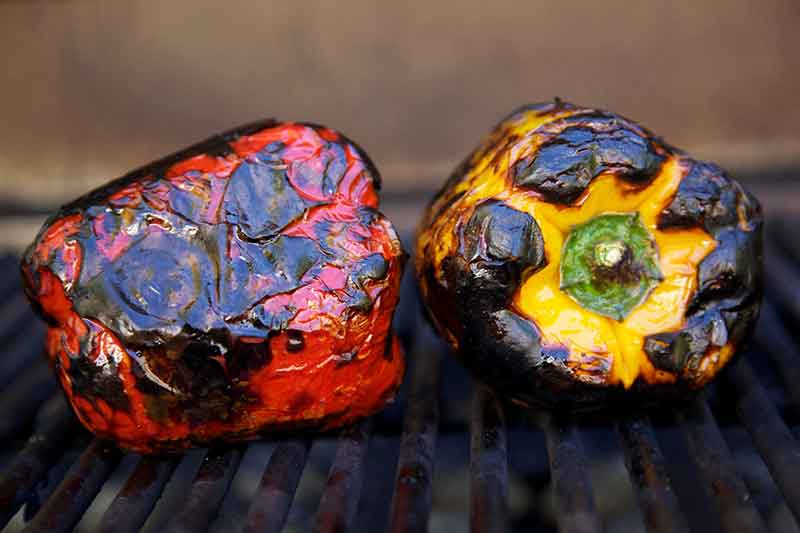Growing Your Own Bell Peppers
With good soil, proper temperatures and a little TLC, growing bell peppers is a simple, satisfying garden project — even if you're planting your first garden. Learning these pepper-growing basics is all it takes to experience the garden-to-table goodness of homegrown bell peppers:
- Choosing Bell Pepper Varieties
- Getting Bell Peppers Started Right
- Cultivating Backyard Bell Peppers
- Managing Pepper Pests and Diseases
- Enjoying Your Bell Pepper Harvest

Choosing Bell Pepper Varieties
When thinking of sweet bell peppers, supermarket types may come to mind. Big, glossy, green bells are grocery staples, and bright, shiny red bells follow close behind. But when you grow your own peppers, the menu expands to hundreds of varieties. Most, but not all, start out green and then mature in color and sweetness. Pepper varieties range from deep purple and chocolate-brown to creamy ivory, vivid yellow or fiery orange.
Color isn't your only homegrown option. Plant and pepper sizes vary, too. Garden favorites such as King Arthur pepper grow 2 to 3 feet tall and wide, with thick-walled, blocky, green-to-red peppers that grow 4 inches square. Contrast that with the 1- to 2-inch red mini-bells of Cupid or the golden minis of Sweet Golden Baby Belle. At less than 2 feet tall and 1 foot wide, these compact plants are perfect for growing vegetables in containers or small urban spaces.

Getting Bell Peppers Started Right
Peppers are treated as annual vegetables in most gardens, but they're actually tender perennial fruits, like their close relatives tomatoes and eggplants. These tropical natives like hot temperatures and fertile soil. Plant in a location with well-drained soil that gets full, direct sun at least six to eight hours each day. You'll be rewarded with healthy plants and abundant fruit.
Peppers are very sensitive to cold; rush them outside in spring and you'll regret it. In all but the hottest climates, you'll need to start seeds indoors six to eight weeks before your area's last anticipated spring frost. You can also purchase small seedlings to transplant instead. Wait until all danger of frost has passed and nighttime temperatures stay consistently near 60 degrees Fahrenheit before you move pepper plants outside.1
When choosing a site for your bell peppers, stick to garden spots where tomatoes, eggplants, other peppers or potatoes haven't grown for at least three years. These related plants are vulnerable to the same common vegetable diseases, many of which can stay in soil. If you grow in planters or containers, replace the soil every year if any diseases are present.
Cultivating Backyard Bell Peppers
Like most easy-to-grow fruits and vegetables, peppers generally need added nutrition. Phosphorus and calcium are keys to bountiful bell pepper growth. Soil testing reveals your soil pH (5.8 to 6.5 is excellent for peppers1), and gives recommendations for soil amendments and feeding. When needed, amendments such as lime increase soil pH. Gypsum leaves pH constant, but adds calcium to correct calcium deficiencies, a primary cause of blossom end rot.
When growing bell peppers, avoid high-nitrogen fertilizers, which stimulate leafy growth instead of fueling sweet fruits. Products designed for tomatoes and vegetables, such as Lilly Miller MORCROP Tomato & Vegetable Food 5-10-10, provide higher relative amounts of phosphorus and potassium in the nutrient balance peppers prefer.
Keep bell peppers well-watered, but never leave soil soggy. Water to moisten soil about 6 inches deep, then let it dry slightly. Watering is especially important during fruit set, when tiny peppers take the place of blossoms, and as the bells mature. Consistent moisture helps keep peppers firm and healthy.

Managing Pepper Pests and Disease
Keeping pepper plants fed and watered well goes a long way in preventing opportunistic garden diseases and insect pests, which can hit pepper crops fast and hard. Pepper pests vary by region, ranging from common cutworms to flea beetles, pepper weevils, slugs and snails, and others. Proven pesticides such as Sevin brand — trusted by gardeners for more than 50 years — are an integral part of an effective integrated pest management program for peppers.
Sevin brand garden pesticides provide powerful protection against a broad range of pepper pests, whatever type of pesticide product you prefer. Sevin Insect Killer Concentrate and Sevin Insect Killer Ready to Spray liquids kill more than 500 insect pests by contact and keep protecting your garden for up to three months.+ Sevin Insect Killer Dust Ready To Use starts working immediately on contact to kill more than 150 listed insects.
Always follow product guidelines for the required time between pesticide application and harvest — known as pre-harvest intervals, or PHI. With liquid Sevin Insect Killer in concentrate and ready-to-spray formulas you can treat bell peppers right up to one day before harvest. But with Sevin Insect Killer Dust Ready To Use, allow 7 days between treating and harvesting peppers

Enjoying Your Bell Pepper Harvest
Depending on your chosen varieties, peppers mature between two and three months from the time you transplant outdoors. If you're in the mood for green bells, let them reach full size, form and firmness before you pick. For mature, colored peppers, let them reach full color and ripeness on the vine whenever possible. Then pick them promptly to encourage more pepper fruits to set.
If cold weather cuts your season short, pick peppers early. Keep them warm and humid — between 68 F and 77 F, with 95% or higher humidity — and they may color fully. However, they generally won't grow any sweeter. Peppers start losing water as soon as they're picked, so high humidity is important. If you need to store them for a time, refrigerate bells at 45 F and 95% humidity. Garden-fresh bell peppers should stay firm and flavorful for three to five weeks at those conditions.2
Whether your pepper patch boasts classic green and red or a rainbow of colors, you'll discover just how simple and rewarding growing your own sweet bell peppers can be. GardenTech and the family of GardenTech brands are here to help you succeed and enjoy a bounty of nutritious, homegrown garden goodness.
+Except fire ants, fleas, ticks and mosquitoes.
Always read product labels thoroughly and follow instructions, including guidelines for pre-harvest intervals (PHI) and application frequency.
Sources:
1. R. J. Dufault and N. Doubrava, "Pepper," Clemson University Cooperative Extension, January 2009.
2. M. Cantwell, "Bell Pepper: Recommendations for Maintaining Postharvest Quality," UC Davis Postharvest Technology.
Get Monthly Gardening Advice!





